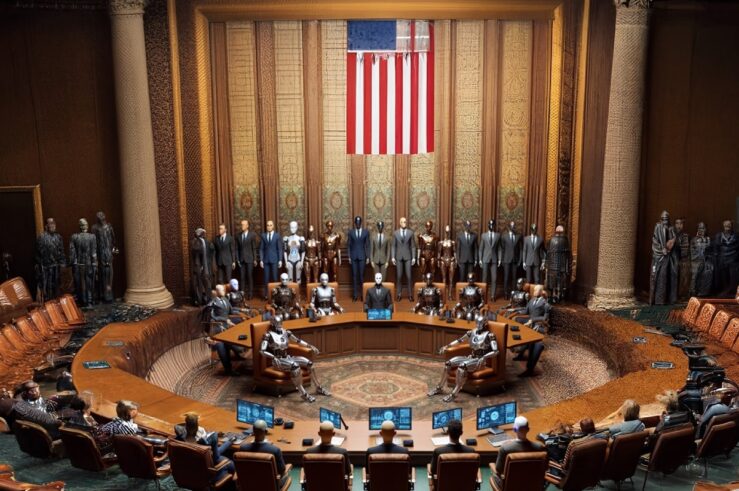In our blog post this morning on ABC v. Aereo, we explain why, regardless of which test applies (the majority’s “looks-like-cable-TV” test or the dissent’s volitional conduct test), Aereo infringes on television program owners’ exclusive right under the Copyright Act to publicly perform their works. We also explain why the majority’s test is far less ambiguous than its critics assert, and why it does not endanger cloud computing services like so many contend.
Because that post was so long, and because the cloud computing issue is key to understanding the implications of this case, this post pulls out the cloud computing argument from that post and presents it separately.
In our April essay on these pages, we identified several reasons why the Court could and should rule against Aereo without exposing innovative cloud computing firms to copyright liability:
- Both fair use and the DMCA’s safe harbor likely protect cloud hosting services such as Dropbox so long as they respond to takedown notices and are not otherwise aware of the nature of the content uploaded by their users;
- Cloud computing services typically lack the volitional conduct necessary to be considered direct infringers; and
- If consumers acquire licensed content from cloud services such as Amazon or Google, and stream themselves that content from the cloud, the services’ privity with rights holders should render them safe from copyright infringement liability.
The Court explicitly endorsed our privity argument and implicitly acknowledged our point about DMCA and fair use. As the Court wrote:
[A]n entity that transmits a performance to individuals in their capacities as owners or possessors does not perform to ‘the public,’ whereas an entity like Aereo that transmits to large numbers of paying subscribers who lack any prior relationship to the works does so perform.
The majority’s “looks-like-cable-TV” test (the dissent’s name for it, not ours) actually offers a clearer basis for distinguishing cloud services than the dissent’s (and our earlier blog post’s) volitional conduct test.
Many commenters lament that the Court’s decision leaves cloud computing in peril, offering no real limiting principle (as, they claim, applying the volitional conduct test would have). Vox’s Timothy B. Lee, for example, opines that:
The problem is that the court never provides clear criteria for this “looks-like-cable-TV” rule…. The Supreme Court says its ruling shouldn’t dramatically change the legal status of other technologies…. But it’s going to take years of litigation — and millions of dollars in legal fees — to figure out exactly how the decision will affect cloud storage services.
But the Court did articulate several important limits, in fact. Most significantly, the opinion plainly excepts transmission of underlying works “own[ed] or possess[ed]” by subscribers from its definition of public performance. It also circumscribes what constitutes a public performance to transmissions from a person to large groups of people “outside of [her] family and [her] social circle,” and reinforces that fair use limitations continue to protect those who perform copyrighted works.
At the same time, the Court characterizes Aereo—and the aspect of the service that give rise to its liability—as “not simply an equipment provider…. Aereo sells a service that allows subscribers to watch television programs, many of which are copyrighted, almost as they are being broadcast.”
Crucially, Aereo makes available to each of its subscribers copyrighted content that he or she does not necessarily otherwise own or possess—even if the company also offers its viewers “enhancements” much like a modern cable system. As we noted in our previous post, this distinguishes Aereo from the cloud computing services to which it is compared:
Cloud computing providers, on the other hand, offer services that enable distinct functionality independent of the mere retransmission of copyrighted content.
Even if the Court’s holding were applied in contexts beyond traditional television programming, how many cloud services actually deliver content—rather than just enhancing it, as a DVR does—that its users do not otherwise own or possess? Vanishingly few, if any. Most obviously, talk of the risks Aereo poses to cloud storage and digital lockers—services that, by definition, apply only to content provided by the user and thus previously “owned or possessed” by the user—is simply misplaced.
Insofar as the transmission of third-party content is the defining characteristic of a “looks-like-cable-TV” system, the Court’s test actually offers a fairly clear delineation, and one that offers no risk to the vast majority of cloud services. This may remind many of Justice Potter Stewart’s infamous “I know it when I see it” test for adjudging obscenity, but it firmly removes a large swath of cloud computing services from the risk of direct copyright liability under Aereo.
And to the extent that some cloud services might seem to fail this test—YouTube, for example—those services (like YouTube and unlike Aereo) routinely obtain performance licenses for the content they provide. Although some of YouTube’s content may not be legally provided to the service, that doesn’t affect its direct copyright infringement liability. Instead, it merely affects the indirect liability YouTube faced before Aereo and continues to face after Aereo. And any such providers that do not currently obtain public performance licenses can and will simply do so with small textual amendments to their existing content licenses.
In other words, the Court’s ruling boils down to this: Either get a license to provide content not already owned by your subscribers, or provide only that content which your subscribers already own. The crux of the Aereo ruling is remarkably clear.
Meanwhile, the volitional conduct test, like most legal tests, doesn’t offer a bright line, despite some commenters’ assertions that it would have been a better grounds for deciding the case. While the volitional conduct test is an imprecise, sliding scale—regardless of the type of service or the underlying relationship between end-users and content providers—the Court’s Aereo test offers relatively clear rules, imposing direct liability only on services that transmit without a public performance license content that its users do not already own or possess.
For the many cloud services we know and love—and for the cloud computing startups yet to exist—the Court’s decision in Aereo should be little cause for concern. Legitimate hand-wringing over potential threats to the cloud will have to wait until another day.






